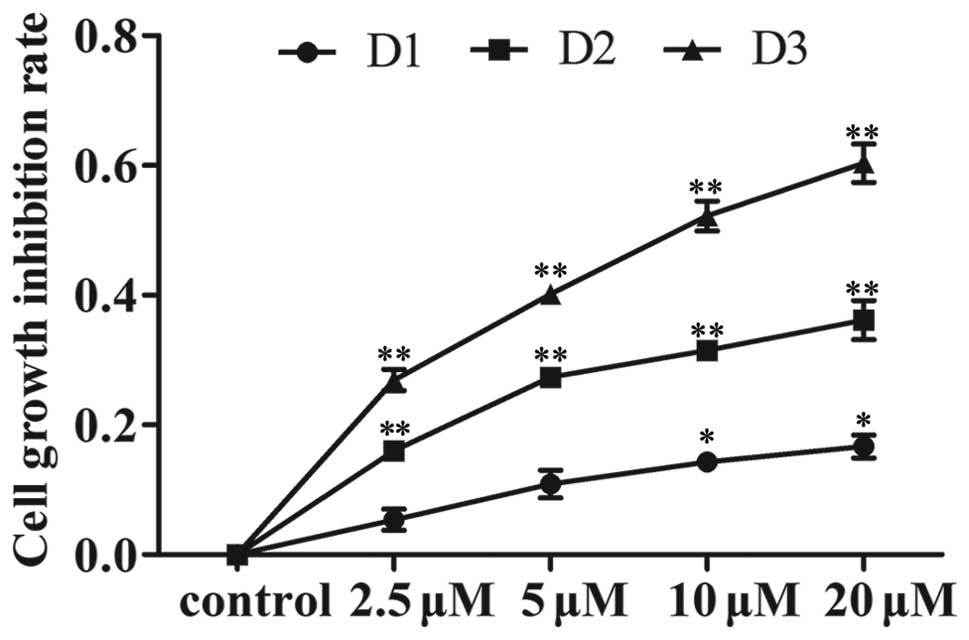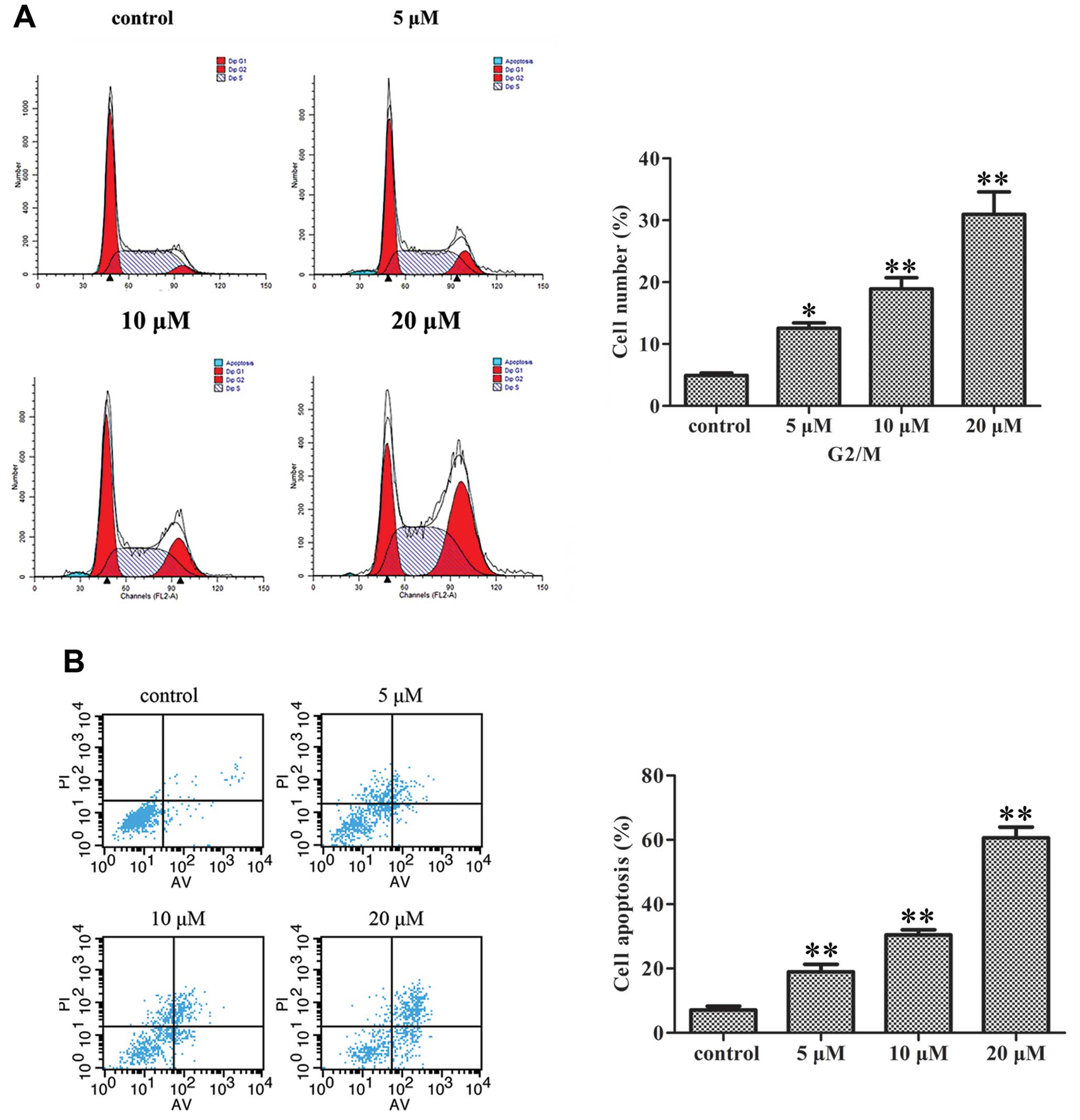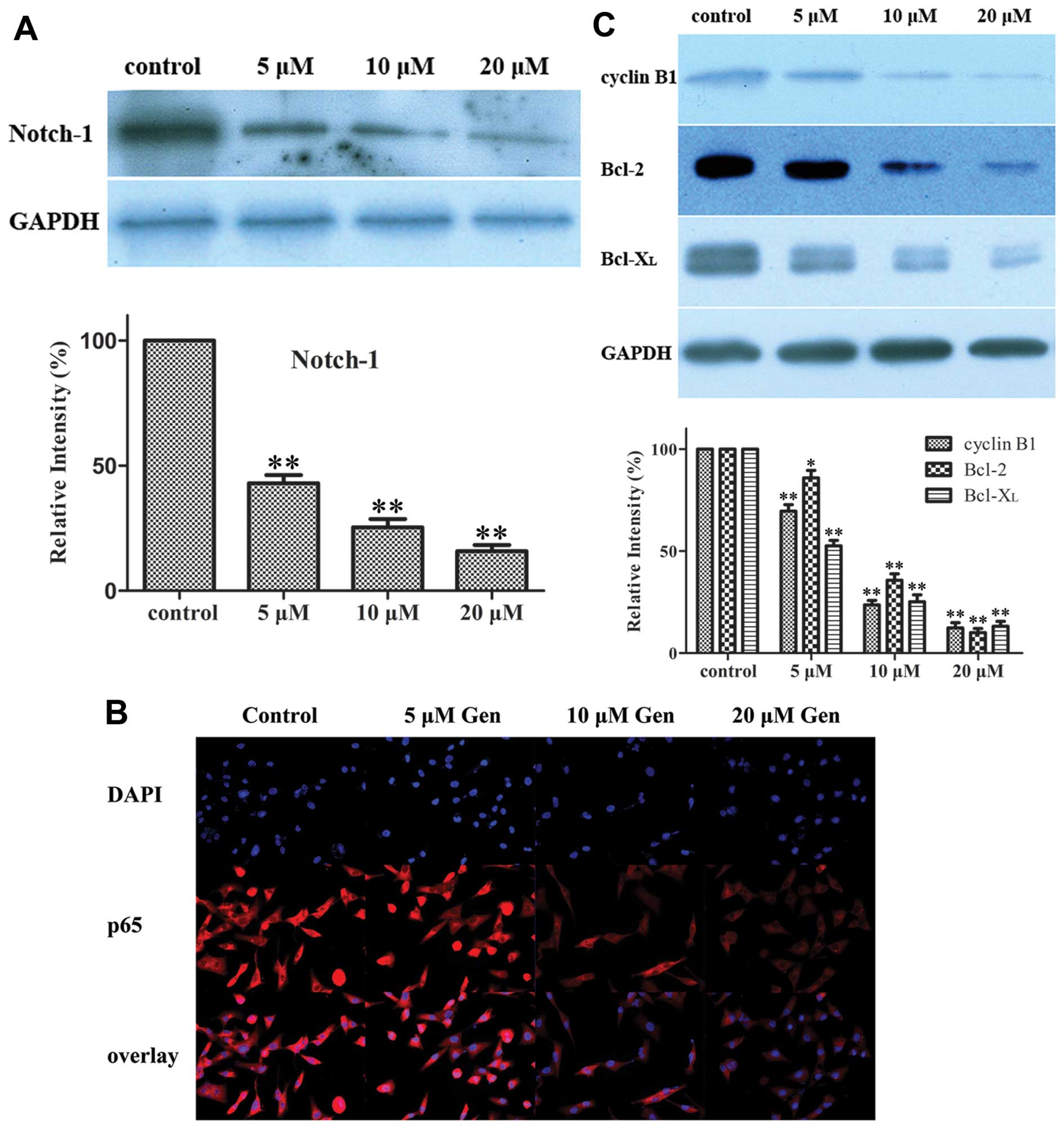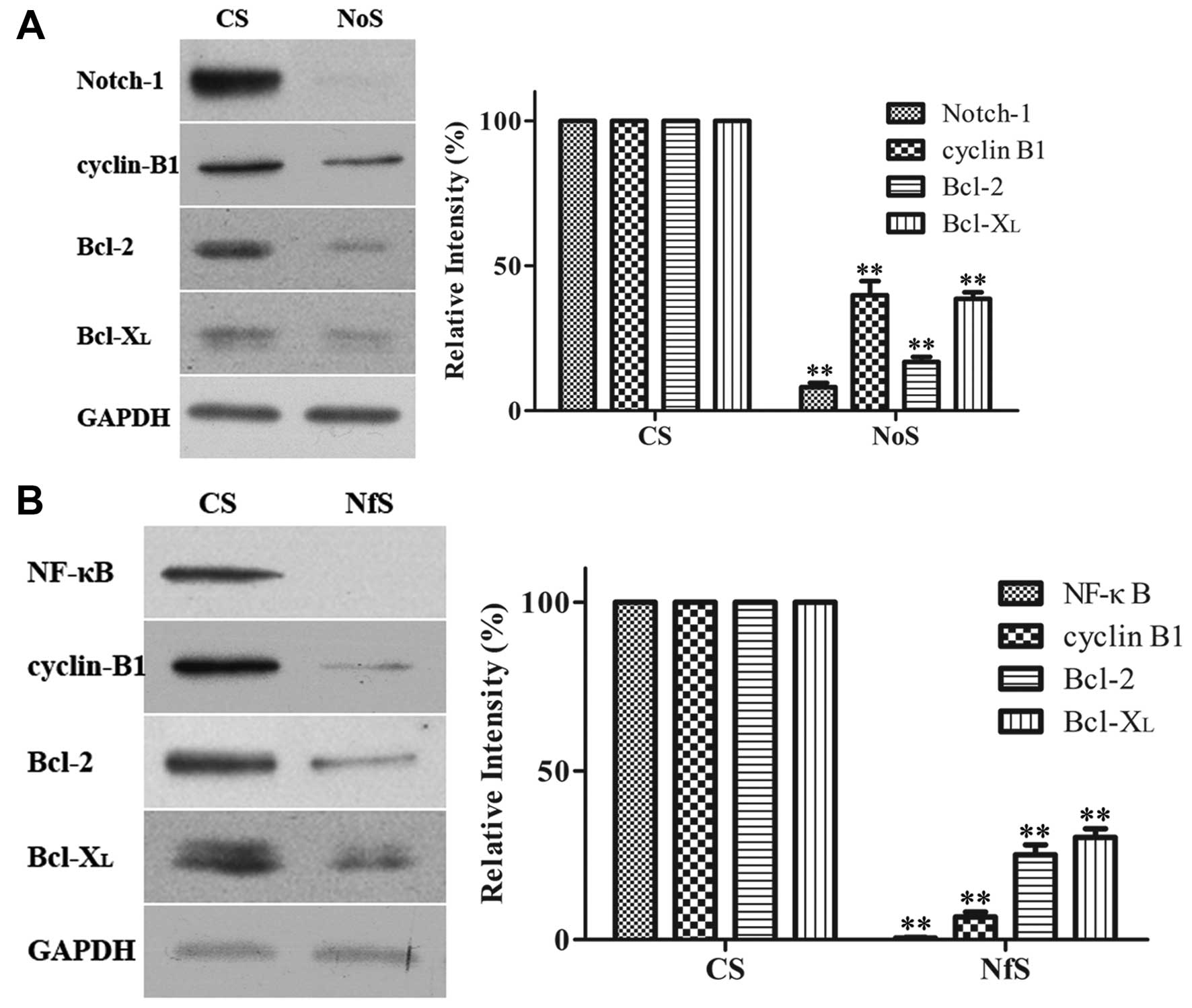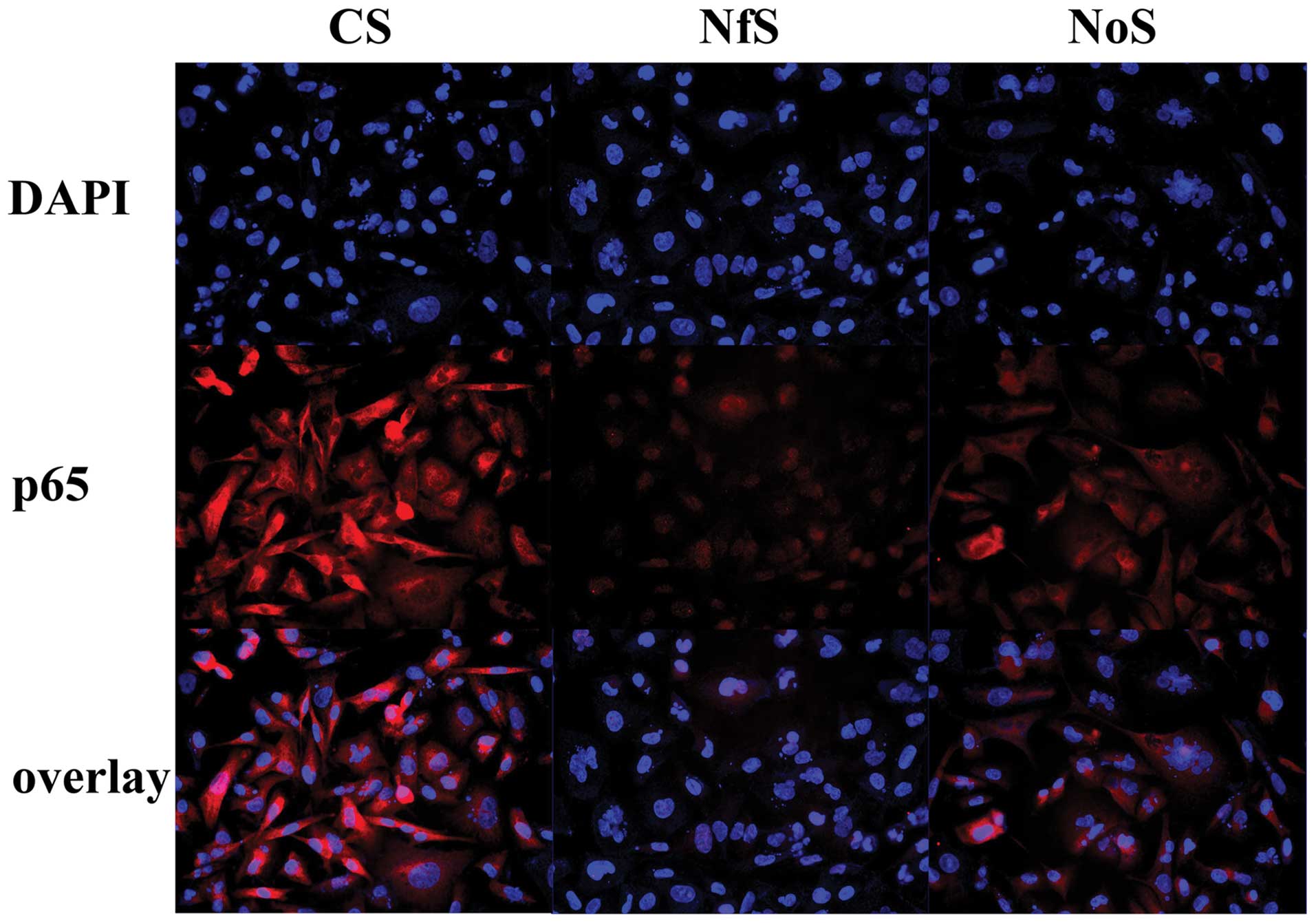Genistein inhibits MDA-MB-231 triple-negative breast cancer cell growth by inhibiting NF-κB activity via the Notch-1 pathway
- Authors:
- Published online on: May 9, 2012 https://doi.org/10.3892/ijmm.2012.990
- Pages: 337-343
Abstract
Introduction
Breast cancer is a common malignant disease in women and is the second leading cause of cancer-related deaths in the United States (1,2). Although the mortality rate has declined in developed countries, a significant number of patients (3–8), whose features include the negative expression of estrogen receptor-α (ER-α), progesterone receptor (PR), and human epidermal growth factor receptor 2 (Her2) demonstrate aggressive clinical behavior and poor outcome. This subgroup of breast cancer patients are defined as triple-negative breast cancer patients (TNBC).
Notably, TNBC represents approximately 15% of all breast cancers (3), and is diagnosed more frequently in younger and premenopausal women (4–8). Patients with TNBC have the disadvantage of not benefiting from currently available receptor-targeted systemic therapy, such as hormonal and trastuzumab-based therapies. Thus, chemotherapeutic regimens have been the mainstay available treatments which always bring variable efficacy. Therefore, the development of novel molecular targeted therapeutic strategies is required.
Genistein (Gen), one of the major soy isoflavones in soy products, was reported as a protective factor against breast cancer (9). Epidemiological evidence strongly supports that Asian women, who consume a diet high in soy products, have a relatively low incidence of breast cancer and risk of breast cancer recurrence (10–13). Previous studies have suggested that Gen can inhibit the cell cycle, induce cell apoptosis, and promote cell differentiation for TNBC breast cancer cells (14,15). Gen, a relative nontoxic natural agent, may become another therapeutic option for the treatment of breast cancer, especially for TNBC. However, the mechanisms of its action remain unclear.
Notch-1 signaling pathway plays a critical role in breast cancer (16). Importantly, the study indicated that targeting Notch signaling pathway with γ secretase inhibitors (GSI) should be explored to further improve the survival rate of TNBC patients. Nonetheless, GSI may have widespread adverse effects in vivo because proteases participate in a wide array of cellular functions (17). It is essential to investigate whether Gen is an efficient agent substituting for GSI to overcome these limitations. Additionally, nuclear factor-κB (NF-κB) is a putative target gene of activated Notch-1 (18), which is another major cell growth and apoptosis regulatory pathway. In the present study, we investigated whether Gen inhibits triple-negative breast cancer MDA-MB-231 cells growth via the Nocth-1 signaling pathway.
The MDA-MB-231 cell line is a typical TNBC line. Our data demonstrate for the first time, to our knowledge, that Gen inhibits triple-negative breast cancer MDA-MB-231 cell growth by inhibiting NF-κB activity via the Nocth-1 signaling pathway. Our study suggests that Gen may be a potential therapeutic agent for TNBC.
Materials and methods
Cell culture
The human breast cancer cell line MDA-MB-231 was obtained from the American Tissue Culture Collection (ATCC). The cells were routinely cultured in complete medium (DMEM supplemented with 10% fetal bovine serum, 100 U/ml penicillin, and 100 μg/ml streptomycin) in a 5% CO2 37°C incubator. Gen (Sigma, USA) was dissolved in dimethyl sulfoxide (DMSO), and was added directly to the culture media at different concentrations. The concentration of DMSO (0.05%) in the final working solution did not interfere with cell growth. The same concentration of DMSO was present in all control cultures.
siRNA plasmid and transfection
MDA-MB-231 cells were transfected with Notch-1 siRNA, NF-κB siRNA and siRNA controls (GenePharma, China), using Lipofectamine 2000. One day before transfection, cells were plated in 2 ml DMEM without antibiotics. siRNA of 5 µl (final concentration 100 pM) and 5 µl Lipofectamine 2000 were diluted in 250 µl opti-MEM medium without serum separately, mixed gently and incubated for 5 min at room temperature. Subsequently, the diluted oligomer was combined with the diluted Lipofectamine 2000. The combination was incubated for 20 min at room temperature, and added to each well containing cells and medium. The medium were changed after 6 h.
Cell growth inhibition studies by the MTT assay
MDA-MB-231 cells were seeded at a density of 5×103 cells/well in 200 μl of medium in a 96-well culture plates, and cultured for 24 h. The cells were treated with 5, 10, 20 μM Gen for 24, 48 and 72 h, while control cells were cultured in medium with 0.05% DMSO. After treatment, the cells were incubated with MTT (0.5 mg/ml) at 37°C for 4 h and with DMSO at room temperature for 15 min. The absorbance of the samples was measured at 490 nm on a scanning multi-well spectrophotometer. The experiment was repeated 3 times.
Quantitative apoptotic cell death assay
MDA-MB-231 cells were seeded in 6-well culture plates, and subsequently treated with 5, 10 and 20 μM Gen for 72 h, while control cells received 0.05% DMSO in culture medium. After treatment, the floating and adherent cells were collected. Pooled cells were washed with phosphate-buffered saline (PBS). The cells were suspended in 100 μl PBS and mixed with 5 μl of Annexin V-FITC and 10 μl of propidium iodide. The cells were analyzed with a flow cytometer after 15 min of incubation in the dark.
Cell cycle analyses
MDA-MB-231 cells were synchronized in G0 by serum starvation for 24 h in serum-free medium. Subsequently, cells were incubated in complete phenol red-free DMEM containing 10% fetal bovine serum for 72 h with or without various concentrations of Gen. After treatment, cells were trypsinized and washed in cold PBS twice, fixed in 70% ethanol over 6 h at 4°C. The distribution of cells at different stages of the cell cycle was estimated by flow cytometric DNA analysis. The percentage of cells in each cell cycle phase (G0/G1, S or G2/M) was calculated by using Lysis II software.
Determination of NF-κB activity
MDA-MB-231 cells were seeded in a 6-well culture plate, and treated with 0, 5, 10 and 20 μM Gen for 72 h. The cells were immunofluorescence-labeled according to the manufacturer’s instructions using the NF-κB activation-nuclear translocation assay kit (Beyotime Biotech, China). After washing and fixing, cells were incubated with a blocking buffer for 1 h to suppress non-specific binding. Next, cells were incubated with the primary NF-κB p65 antibody at 4°C overnight, followed by incubation with a Cy3-conjugated secondary antibody for 1 h, then with DAPI for 5 min before observation. NF-κB p65 protein and nuclei fluoresce red and blue respectively, and can be simultaneously viewed by laser confocal microscope at an excitation wavelength of 350 nm for DAPI and 540 nm for Cy3. To create a two-color image, the red and blue images were overlaid, producing pink fluorescence in areas of co-localization.
For the siRNA transfected effect, the assay was performed as described above 72 h after the cells were transfected with Notch-1 siRNA, NF-κB siRNA or siRNA control.
Western blotting
After treatment, cells were washed twice with cold PBS and then scraped off in 500 μl of buffer RIPA (with PMSF) and incubated on ice for 30 min. Then, cell lysates were centrifuged at 14,000 x g for 15 min, and the supernatants were stored at −80°C. Protein concentrations were measured by use of the BCA protein assay. The prepared proteins were boiled for 5 min, and separated by 12% SDS-PAGE. Proteins were transferred to PVDF membranes, which were activated in methanol. The membranes were immunoblotted with anti-rabbit Notch-1 (Abcam), cyclin B1, Bcl-2, Bcl-xL (Cell Signaling Technology) and GAPDH (Santa Cruz Biotechnology, Inc.) antibody, and anti-mouse NF-κB antibody, followed by secondary anti-mouse antibody and anti-rabbit antibody. GAPDH was used to normalize for protein loading. The membranes were probed using ECL and autoradiographed. All experiments were performed three times. The intensity of the bands was determined using densitometric analysis.
Statistical analyses
Data are expressed as means ± standard deviation (SD). Comparisons were made between control and treatment groups. Statistical differences were analyzed using one-way ANOVA. P-value <0.05 was considered to indicate statistical significance.
Results
Gen inhibits proliferation in MDA-MB-231 cells
MDA-MB-231 cells were exposed to Gen at concentrations of 5, 10 and 20 μM, while the control cells received 0.05% DMSO in the medium. Subsequently, cell proliferation was determined by the MTT assay at 24, 48 and 72 h. A time-dependent and dose-dependent inhibition of cell growth was observed (Fig. 1).
Gen induces apoptosis in MDA-MB-231 cells
MDA-MB-231 cells (0, 5, 10 and 20 μM Gen for 72 h) were collected, and stained with Annexin V and propidium iodide. The Gen-induced apoptosis was investigated by flow cytometry. The result showed that Gen induced apoptosis in a dose-dependent manner (Fig. 2A). The apoptosis percentages of all MDA-MB-231 cells treated with 0, 5, 10 or 20 μM Gen were 6.78, 18.98, 30.45 and 60.64%, respectively.
Gen-treated MDA-MB-231 cells arrest in the G2/M phase of the cell cycle
MDA-MB-231 cells were treated with 0, 5, 10 or 20 μM concentrations of Gen for 72 h, and the cell cycle phase was determined by flow cytometry. Gen induced a significant accumulation of cells in the G2/M phase of the cell cycle in a dose-dependent manner (Fig. 2B). The percentages of cells in the G2/M phase of the cell cycle after treatment with 0, 5, 10 or 20 μM were 4.93, 12.54, 18.93 and 30.95%, respectively.
Gen inhibits the NF-κB pathway through the Notch-1 pathway in MDA-MB-231 cellsGen inhibits Notch-1 expression
To investigate whether the Notch-1 pathway is involved in the action of Gen, western blot analysis was used to determine the status of Notch-1 in MDA-MB-231 cells treated with different concentrations of Gen (0, 5, 10 and 20 μM). We found that the protein level of Notch-1 was downregulated in MDA-MB-231 cells in a dose-dependent manner (Fig. 3A).
Gen inhibits NF-κB activation and NF-κB targeted proteins
The nuclear translocation assay kit was used to determine NF-κB activation. The results showed that various concentrations of Gen can downregulate NF-κB activation in MDA-MB-231 cells in a dose-dependent manner (Fig. 3B). Western blot analysis showed that the levels of NF-κB targeted proteins, cyclin B1, Bcl-2, Bcl-xL, were downregulated in MDA-MB-231 cells treated by Gen compared with the control cells (Fig. 3C).
NF-κB inactivation is mediated via the Notch-1 pathway
Both Notch-1 and NF-κB were downregulated by siRNA (Fig. 4). The transfection of Notch-1 siRNA into MDA-MB-231 cells inhibited the translocation of NF-κB into the nucleus (Fig. 5). The downregulation of Notch-1 and NF-κB expression by siRNA both inhibited the expression of cyclin B1, Bcl-2 and Bcl-xL (Fig. 4). These results suggest that NF-κB inactivation was mediated via the Notch-1 pathway.
Discussion
Our study reveals that Gen elicits a dramatic effect on cell growth inhibition in a dose-dependent and time-dependent manner. Gen induced MDA-MB-231 cell apoptosis and induced cell cycle arrested in the G2/M phase. On the other hand, we examined the mechanisms of the action of Gen on MDA-MB-231 cells. We demonstrated for the first time, to our knowledge, that in TNBC cells, inhibition of the activity of NF-κB via the Notch-1 pathway may be an important mechanism for growth inhibition by Gen. What’s more, we found that Gen downregulated the expression of cyclin B1, Bcl-2 and Bcl-xL in MDA-MB-231 cells, possibly mediated by NF-κB activation via the Notch-1 signaling pathway. Based on the results, we speculate that Gen is a potential therapeutic agent for TNBC.
Gen, as one of the major soy isoflavones in soy products, is a relatively nontoxic natural agent. Apart from its efficiency, attention needs to be paid to its safety. Because of its structural similarity with 17β-estradiol, Gen has the capacity to bind to ERα and induce hormone-like effects. Thus, at lower dose (<10 µM) Gen may stimulate ERα+ cell growth and entry into the cell cycle. However, there is no need to worry about these effects on TNBC cells, like MDA-MB-231 cells, in the present study. Notably, numerous epidemiological studies support a significant inverse association between soy isoflavones intake and risk of breast cancer incidence and recurrence. Gen may be a potential attractive therapeutic agent for TNBC.
The Notch pathway is an important transduction pathway in cancer cells, which is always aberrantly activated in breast cancer (19). Notch signaling is normally activated by ligand-receptor binding between two neighboring cells (20). It consists of Notch receptors (Notch-1–4), Notch ligands (Delta-like-1, −3, −4, and Jagged-1, −2) and CSL (DNA binding protein) (21). High-level co-expression of Notch-1 and Jagged-1 has been associated with poor overall survival (22–24). Based on previous studies, Notch signaling pathway plays a critical role in controlling breast cancer cell growth and apoptosis (25). Considering the CBF-1 transcriptional activity, reported by Rizzo et al (26), it is suggested that factors other than expression levels of Notch-1 regulate Notch-dependent reporter activity. A previous study demonstrated that the TNBC cell line MDA-MB-231 had much higher Notch-dependent reporter activity than the ERα+ lines (MCF-7 and T47D) and Her2/Neu overexpression line SKBR3. Importantly, the Notch-1 signaling pathway has been demonstrated to play a critical role in TNBC (14). It was reported that MDA-MB-231 xenografts were highly sensitive to the treatment of GSI, a Notch inhibitor (26). Therefore, the Notch-1 pathway is a rational target of breast cancer, especially for TNBC. We demonstrated for the first time, to our knowledge, that Gen inhibits the Notch-1 signaling pathway in MDA-MB-231 cells.
Additionally, NF-κB is a putative target gene of activated Notch-1 (18). Numerous studies have documented elevated NF-κB DNA-binding activity in both mammary carcinoma cell lines and primary human breast cancer tissues (27–29). NF-κB controls breast cancer initiation, progression, metastasis, and resistance to chemotherapy (30). Our study reveals that various concentrations of Gen can downregulate NF-κB activation in a dose-dependent manner.
Translocation of NF-κB into the nucleus can activate transcription of genes (31). We found that Gen downregulated expression of cyclin B1, Bcl-2 and Bcl-xL in MDA-MB-231 cells, possibly mediated by NF-κB, via the Notch-1 signaling pathway. Furthermore, our data suggests that knockdown of Notch-1 or NF-κB by siRNA leads to downregulation of cyclin B1, Bcl-2 and Bcl-xL in MDA-MB-231 cells. Cyclin B1 is a cell cycle regulatory protein, which is overexpressed in breast cancer (32). Decreasing cyclin B1 expression inhibits proliferation and induces apoptosis in tumor cells (33). Bcl-2 protein is a member of the Bcl-2 family that regulates apoptosis, which is a potent inhibitor of apoptosis (34). As far as breast cancer is concerned, Bcl-2 protein is generally expressed in 60–80% of invasive breast carcinoma (35,36). To date, Bcl-xL, another member of the Bcl-2 family, has been shown to correlate with chemotherapy resistance of mammary tumors in a mouse model (37).
In conclusion, the results of our study demonstrate that Gen inhibits triple-negative breast cancer MDA-MB-231 cell growth by inhibiting NF-κB activity via the Nocth-1 signaling pathway. Our study gives strong evidence that Notch-1 is an attractive molecular target for the treatment of TNBC. Gen may be used alone or in combination, to achieve better treatment outcome of TNBC. Further preclinical and clinical studies should be performed to confirm the hypothesis to apply the use of Gen in patients with TNBC.
Acknowledgements
This study was mainly supported by the Foundation from Jiangsu provincial administration of traditional Chinese Medicine (LZ11079). This study was also supported in part by the National Natural Science Foundation of China (81071753 and 81172502), the Wu Jie-Ping Foundation (320.670010009), the Six Kinds of Outstanding Talent Foundation of Jiangsu Province (2010-ws-079 to W.H. and 2009 to Q.D.), the Science and Education for Health Foundation of Jiangsu Province (RC2007054), the Natural Science Foundation of Jiangsu Province (BK2009438, BK2010581, BK2011853 and BK2011855), the Program for Development of Innovative Research Team in the First Affiliated Hospital of NJMU (IRT-008), and a project funded by the Priority Academic Program Development of Jiangsu higher Education Institutions (PAPD).



